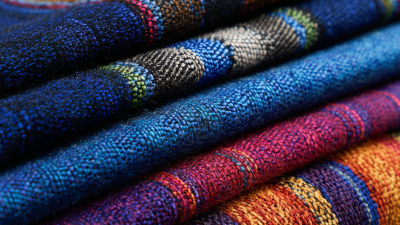In 2024, the knitted apparel fabric sector is poised for significant transformation, driven by evolving consumer preferences and technological advancements. As per recent market research reports, the global knitted fabric market is projected to reach USD 19.5 billion by 2027, growing at a CAGR of 4.8% from 2020. This growth is propelled by a shift towards sustainable and innovative textile solutions that align with eco-conscious consumer demands. The introduction of advanced knitting techniques, such as 3D knitting and seamless technology, is revolutionizing production efficiency and product versatility. Emphasizing versatility, lightweight characteristics, and comfort, knitted apparel fabric is not only enhancing consumer lifestyle but also presenting manufacturers with opportunities to implement smart textiles and digital printing methods. As we delve deeper into the trends, techniques, and industry insights surrounding knitted apparel fabric, it becomes essential for stakeholders to adapt and innovate to remain competitive in this dynamic market landscape.

As we delve into 2024, the knitted apparel industry is witnessing a fascinating transformation driven by evolving consumer preferences and sustainable practices.
According to a recent report by Grand View Research, the global knitwear market is projected to reach $67.9 billion by 2025, growing at a CAGR of 4.4%. This growth is indicative of a burgeoning trend towards comfort-driven fashion, with consumers increasingly favoring versatile knits that seamlessly blend style and functionality.
In particular, advancements in knitting technology are shaping the future of knitted apparel. Techniques such as advanced 3D knitting are not only enhancing the production process but also allowing for intricate designs that cater to individual styles. A report by Allied Market Research notes that the adoption of automated knitting technologies can reduce production times by up to 50%, making way for quicker turnaround times in response to fast-changing fashion trends. Additionally, materials like recycled polyester and eco-friendly fibers are gaining momentum, reflecting a growing consumer demand for sustainable and eco-conscious products. These trends are essential for brands aiming to remain competitive in a rapidly evolving market landscape.

In recent years, the realm of knit fabric construction has witnessed a remarkable evolution driven by innovative techniques and technological advancements. According to a report by **Grand View Research**, the global knitted fabric market is expected to reach **USD 30.2 billion by 2024**, growing at a CAGR of **4.5%**. This growth underscores the increasing demand for versatile and performance-driven knitted textiles. Techniques such as 3D knitting and seamless construction are at the forefront, enabling designers to create complex patterns and structures without the traditional limitations of fabric construction.
As brands continue to prioritize sustainability, innovations like yarn recycling and eco-friendly dyeing processes are gaining traction within the industry. The **Textile Exchange** highlights that over **30%** of fabric production now aims at minimizing environmental impact. New knitting machinery allows for the integration of biodegradable materials and reduced water usage, transforming traditional practices into more sustainable processes. These developments not only enhance fabric performance but also align with the growing consumer demand for responsible fashion choices, shaping the future landscape of knitted apparel.
The knitted apparel industry is on the brink of a sustainability revolution, with a growing emphasis on eco-friendly materials. As we look toward 2024, brands are increasingly investing in sustainable fibers, such as organic cotton, recycled polyester, and innovative materials like Tencel. These alternatives not only reduce environmental impact but also cater to the conscious consumer’s demand for ethical fashion.
**Tips**: When sourcing sustainable knitted fabrics, consider certifications like GOTS (Global Organic Textile Standard) to ensure you are choosing truly eco-friendly options. Additionally, explore regional suppliers who focus on sustainable practices to cut down on carbon footprints associated with transportation.
Moreover, innovative knitting techniques play a crucial role in maximizing the efficiency of these sustainable materials. Methods such as digital knitting and seamless technology are not only reducing waste but also allowing for intricate designs while maintaining ease of production. Brands that harness these techniques can stay competitive, offering trendy yet responsible choices to their customers.
**Tips**: Experiment with blending traditional and modern knitting techniques to enhance the aesthetic appeal of your products. Engaging with customer feedback can also inspire creative approaches that meet both style and sustainability goals.
| Trend/Technique | Description | Sustainable Material | Industry Insight |
|---|---|---|---|
| Circular Knitting | A method that minimizes fabric waste by using continuous yarn. | Recycled Polyester | Expected to reduce overall carbon footprint significantly. |
| Seamless Knitting | Creates garments without seams, enhancing comfort and fit. | Organic Cotton | Rising demand from consumers for comfort and sustainability. |
| 3D Knitting Technology | Utilizes computer programming to produce intricate designs. | Bamboo Fiber | Supported by eco-conscious brands focusing on innovation. |
| Biodegradable Yarns | Yarns designed to decompose at the end of their lifecycle. | Tencel® | Growing awareness of environmental impact among consumers. |
| Knitted Textiles with UV Protection | Fabrics that provide UV shielding for outdoor wear. | Recycled Nylon | Increasing importance as consumers seek protection in fashion. |
As knitted apparel continues to evolve, understanding consumer preferences is crucial for brands looking to thrive in the competitive market of 2024. Research indicates that sustainability remains a top priority for consumers, with eco-friendly materials and ethical production processes significantly influencing their purchasing decisions. Shoppers are increasingly drawn to brands that showcase transparency in their supply chains, making choices that not only appeal to their aesthetic but also align with their values.

In addition to sustainability, comfort and versatility are paramount among knitted apparel choices. With the rise of remote work and casual lifestyles, consumers prefer garments that offer both style and ease of wear. Flexible pieces that transition seamlessly from home to outdoor settings, such as oversized cardigans and breathable knit dresses, are gaining traction. Furthermore, the demand for inclusivity in sizing and styles reflects a broader push towards diversity in fashion, encouraging brands to cater to a wider range of body types and personal tastes. Understanding these preferences allows companies to better tailor their collections to meet the evolving needs of their customers.
As the knitted apparel industry evolves, insights from industry leaders reveal significant trends and techniques shaping the future of knitted fabrics. The market is projected to see substantial growth, with estimates indicating an increase from USD 996.79 billion in 2025 to a staggering USD 2481.20 billion by 2033. This rapid expansion highlights the increasing demand for innovative knitwear that blends sustainability with advanced textile technology.
Sustainability has become a focal point for industry stakeholders, as demonstrated in recent events like the Lenzing Conclave, where new fiber technologies were showcased. Innovations in wood-based fibers reflect the broader trend towards eco-friendly materials in knitted apparel. Additionally, the integration of technology, including AI, into textile production processes is redefining how fabrics are created and manufactured. As brands strive to adapt to evolving consumer preferences, the industry's commitment to sustainability combined with cutting-edge advancements promises exciting developments in knitted fabrics for 2024 and beyond.





